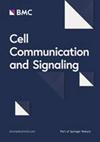钙蛋白酶-1削弱核包膜并促进中性粒细胞胞外捕获物的释放
IF 8.2
2区 生物学
Q1 CELL BIOLOGY
引用次数: 0
摘要
中性粒细胞胞外捕获物(NET)形成的诱导因素多种多样,因此,并不存在NET形成不可或缺的特定途径或标志性分子。但是,组蛋白修饰、染色质解聚、核膜破坏和 NET 释放等某些事件却无处不在。在 NET 形成过程中,中性粒细胞会大幅重新排列其细胞质、颗粒和核内容。然而,NET形成过程中每个步骤的确切解码机制仍未确定。在此,我们研究了NET形成过程中核包膜破裂的机制。免疫荧光显微镜评估显示,在NET形成过程中,核外膜蛋白nesprin-1逐渐解体,核形态也发生了改变。对各种诱导剂产生的NET进行的MALDI-TOF分析检测到了nesprin-1片段的积累。这表明nesprin-1降解发生在NET释放之前。在钙蛋白酶-1抑制剂存在的情况下,钙驱动的NET形成过程中内斯普林-1降解减少。显微镜评估证实,层粘连蛋白 B 受体(LBR)的解体和肌动蛋白细胞骨架的崩溃分别发生在 NET 释放的早期和晚期阶段。我们的结论是,钙蛋白酶-1能降解内斯普林-1,协调核膜的减弱,促进LBR的解体,促进DNA的释放,并最终促进NET的形成。本文章由计算机程序翻译,如有差异,请以英文原文为准。
Calpain-1 weakens the nuclear envelope and promotes the release of neutrophil extracellular traps
The inducers of neutrophil extracellular trap (NET) formation are heterogeneous and consequently, there is no specific pathway or signature molecule indispensable for NET formation. But certain events such as histone modification, chromatin decondensation, nuclear envelope breakdown, and NET release are ubiquitous. During NET formation, neutrophils drastically rearrange their cytoplasmic, granular and nuclear content. Yet, the exact mechanism for decoding each step during NET formation still remains elusive. Here, we investigated the mechanism of nuclear envelope breakdown during NET formation. Immunofluorescence microscopic evaluation revealed a gradual disintegration of outer nuclear membrane protein nesprin-1 and alterations in nuclear morphology during NET formation. MALDI-TOF analysis of NETs that had been generated by various inducers detected the accumulation of nesprin-1 fragments. This suggests that nesprin-1 degradation occurs before NET release. In the presence of a calpain-1, inhibitor nesprin-1 degradation was decreased in calcium driven NET formation. Microscopic evaluation confirmed that the disintegration of the lamin B receptor (LBR) and the collapse of the actin cytoskeleton occurs in early and later phases of NET release, respectively. We conclude that the calpain-1 degrades nesprin-1, orchestrates the weakening of the nuclear membrane, contributes to LBR disintegration, and promoting DNA release and finally, NETs formation.
求助全文
通过发布文献求助,成功后即可免费获取论文全文。
去求助
来源期刊

Cell Communication and Signaling
CELL BIOLOGY-
CiteScore
11.00
自引率
0.00%
发文量
180
期刊介绍:
Cell Communication and Signaling (CCS) is a peer-reviewed, open-access scientific journal that focuses on cellular signaling pathways in both normal and pathological conditions. It publishes original research, reviews, and commentaries, welcoming studies that utilize molecular, morphological, biochemical, structural, and cell biology approaches. CCS also encourages interdisciplinary work and innovative models, including in silico, in vitro, and in vivo approaches, to facilitate investigations of cell signaling pathways, networks, and behavior.
Starting from January 2019, CCS is proud to announce its affiliation with the International Cell Death Society. The journal now encourages submissions covering all aspects of cell death, including apoptotic and non-apoptotic mechanisms, cell death in model systems, autophagy, clearance of dying cells, and the immunological and pathological consequences of dying cells in the tissue microenvironment.
 求助内容:
求助内容: 应助结果提醒方式:
应助结果提醒方式:


